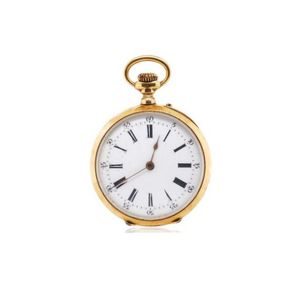Edwardian Period Yellow Gold Ladies Fob Watch, K18 Marked Case
Edwardian period yellow gold ladies fob watch marked K18 to the case & back plate. Approx case width 1.30 in., stem wind movement running when tested, minor bruise to bezel
You must be a subscriber, and be logged in to view price and dealer details.
Register Now to view actual auction price for this item.
- Bezel - On a clock or watch, the bezel is the metal frame into which the watch or clock glass is fitted. In clocks, the bezel may include a hinge and a flange, in effect a door to the face of the clock. In jewellery the bezel is a band of metal with a projecting lip that holds the gemstone in its setting.
- Back Plate - On many types of clocks, the movement operates between two plates, usually made of brass, one at the back, and the other at the front, which forms a mount for the dial.
On English bracket, mantle and table clocks the backplate was often visible through a glass door or panel from the late 17th century, and could be profusely engraved with scrolling decorations, flowers, foliage, birds, and figures. The engraving could also include the maker’s name.
The amount of engraving reduced and became simpler as the 18th century progressed, and by 1800, had been reduced to a border, often with the maker's name in the centre. By the early 1800s all decoration had ceased, and only the maker's name was added, and by the Victorian era, most bracket, mantle and table clocks had no engraving. - Movement - The technical name for the workings of a clock or watch, and does not include the dial or case.
- Edwardian - The Edwardian period of English furniture and decorative arts design is named for Edward VII (1841 – 1910) who was King of the United Kingdom and the British Dominions and Emperor of India for the brief period from 1901 until his death in 1910. It follows the Victorian period, in turn was followed by the Art Nouveau and Art Deco styles. In Australia, designs of this period are also known as being in the Federation style.
This item has been included into following indexes:
